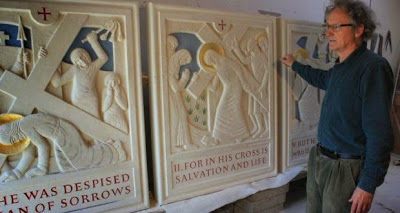| Online: | |
| Visits: | |
| Stories: |

| Story Views | |
| Now: | |
| Last Hour: | |
| Last 24 Hours: | |
| Total: | |
New Stations of the Cross in Ireland
I had not heard of the Irish traditional sculptor Ken Thompson–not to be confused with the abstract Michigan-based sculptor Kenneth M. Thompson–until a priest friend pointed me to this article on a set of Stations of the Cross for St. Mel’s in Longford, Ireland. I am pleased (and not a little amused) at the tone of wonder that accompanies the article, as if the idea that traditional religious art could be an exciting and even fresh thing. Mr. Thompson’s work for the cathedral has a strongly Romanesque cast to it, and yet contains many small touches that are both novel and thoroughly rooted in tradition: the intense intersection of human emotion and stylized iconography, the simple but dignified use of color, and some elements that might seem whimsical to the untutored. (As an aside, I find it puzzling how afraid we are of color these days, design-wise, both within the Church and without). For instance, a mouse appears in a few of the panels:
The remainder, finished or unfinished, indicate that there is a kind of relativism at work in these depictions. That mouse, for example, is a reminder of a traditional belief that as a carpenter St Joseph made mouse-traps. The less benign legend has the mouse as the devil disguised, and Thompson manages to weave this reference into an almost textual example of sermons in stones.
I find it rather comic that the writer considers this “relativism,” when it is clearly a judicious application of the Christian artistic imagination to the work, especially as the priest who directed me to his work tells me Ken is possessed of a genuinely theological sensibility to accompany his great skill as an artist and craftsman. It is undoubtedly apparent in his work. We are so used to imposing an almost Sulpician primness to the great works of previous centuries, we forget all the well-rooted iconographic oddities that gave vigor, wit and even depth to so many paintings and sculptures in cathedrals from Bayeux to Krakow. I am also glad to see that the panels have been given scriptural tags to accompany each number (“II. For in the Cross is Salvation and Life”), rather than the usual museum-catalog headings they often get (“Jesus is condemned to death,” etc.), which invite a healthy interplay between the sacred page and its visual representation. Let us hope for more works that so capture both the technique of our Catholic heritage but also the fruitful, prayerful, literate yet playful mindset that truly made its art breathe and live.
Source: http://www.newliturgicalmovement.org/2014/07/new-stations-of-cross-in-ireland.html






Wonderful! I hope it becomes a trend.